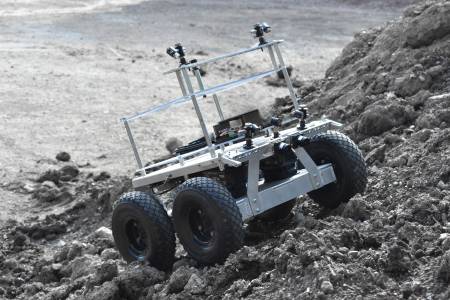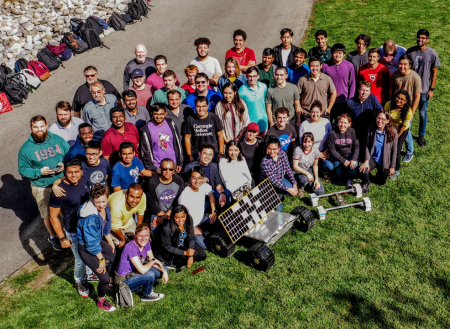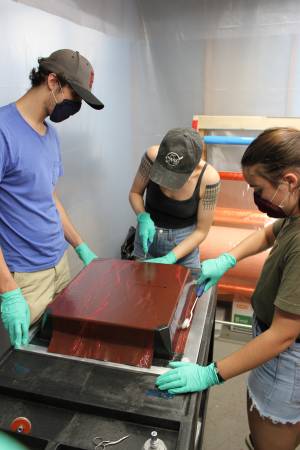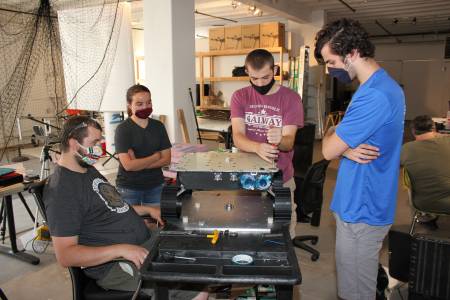Small, Speedy Rover Completes Preliminary Design Review
 PITTSBURGH — MoonRanger, a small robotic rover being developed by Carnegie Mellon University and its spinoff Astrobotic, has completed its preliminary design review in preparation for a 2022 mission to search for signs of water at the moon’s south pole.
PITTSBURGH — MoonRanger, a small robotic rover being developed by Carnegie Mellon University and its spinoff Astrobotic, has completed its preliminary design review in preparation for a 2022 mission to search for signs of water at the moon’s south pole.
Whether buried ice exists in useful amounts is one of the most pressing questions in lunar exploration, and MoonRanger will be the first to seek evidence of it on the ground. If found in sufficient concentration at accessible locations, ice might be the most valuable resource in the solar system, said William “Red” Whittaker, University Founders Research Professor in the Robotics Institute.
“Water is key to human presence on and use of the moon,” explained Whittaker, who is leading development of MoonRanger. “Space agencies around the world are intent on investigating it.”
 Whittaker and his team first approached NASA about using robots to search for lunar ice in 1996, and they will fulfill that vision a quarter century later by landing in 2022.
Whittaker and his team first approached NASA about using robots to search for lunar ice in 1996, and they will fulfill that vision a quarter century later by landing in 2022.
“This hasn’t been quick or easy,” Whittaker said. “It is stunning that after these many years we will have the first look.”
NASA will follow MoonRanger at a later date with its more capable Volatiles Investigating Polar Exploration Rover (VIPER), which will perform more rigorous and sustained exploration and scientific characterization of the ice.
MoonRanger’s lander will be the Masten Space Systems’ XL-1, supported by the NASA Commercial Lunar Payload Services program. The rover will be one of eight science and technology payloads, which are supported by the NASA Lunar Surface Instrument and Technology Payloads program.
The space agency said the payloads support its Artemis program, which aims to return U.S. astronauts to the moon in the coming years.
 Last month, reviewers determined the viability of the design for the rover and its mission. Lydia Schweitzer, a master’s student in computational design who led the systems engineering team, said the two-day review involved more than 60 people — including veterans of the Apollo program and Mars rover project — who provided important suggestions and feedback.
Last month, reviewers determined the viability of the design for the rover and its mission. Lydia Schweitzer, a master’s student in computational design who led the systems engineering team, said the two-day review involved more than 60 people — including veterans of the Apollo program and Mars rover project — who provided important suggestions and feedback.
Schweitzer said the project involved a dozen faculty and staff members, as well as at least 90 students, including three semesters of enrollees in Whittaker’s project course. Disciplines represented on the team comprise engineering, robotics, computer science, software engineering, human-computer interaction, architecture and design. The team also has taken advantage of a network of CMU alumni with expertise in space robotics to solve problems and optimize the rover’s design.
Even as MoonRanger takes shape, Whittaker and another student team continue to prepare for a 2021 mission in which a four-pound CMU rover called Iris and a CMU art package called MoonArk will travel to the moon on Astrobotic’s Peregrine lander.
MoonRanger features a number of technical innovations. About the size of a suitcase, it is designed to repeatedly explore at the rate of 1,000 meters per Earth day in both sunlit and dark conditions — unprecedented speed for a planetary rover. By contrast, a Chinese robot now on the far side of the moon has averaged less than a meter per Earth day.
Unlike other rovers, MoonRanger doesn’t carry isotope heating, so its battery and electronics will fail when night falls and cryogenic temperatures set in. Hence, the robot must accomplish its mission in less than the 14 sunlit Earth-days of the lunar month. It also is light and can’t carry a big radio for communicating directly with Earth. It thus must return to the lander, with which it will establish short-range wireless communication so the lander’s radio can relay the robot’s findings to Earth.
“MoonRanger is going to be on its own for long periods of time,” said David Wettergreen, research professor of robotics and co-investigator for the rover project, noting the rover will be out of touch with controllers on Earth as it does its explorations
 The mission was originally designed to demonstrate the capability of the rover. But NASA expanded it this spring to include the search for ice by adding its Neutron Spectrometer System (NSS) to MoonRanger. The NSS, developed by NASA Ames Research Center, measures the amount of hydrogen in the upper layer of the moon’s soil, called regolith. Hydrogen abundance is correlated with the concentration of buried water ice. The NSS will be along for the ride, “ticking like a Geiger counter” when the rover passes over buried ice, then falling silent in bone-dry areas, Whittaker said.
The mission was originally designed to demonstrate the capability of the rover. But NASA expanded it this spring to include the search for ice by adding its Neutron Spectrometer System (NSS) to MoonRanger. The NSS, developed by NASA Ames Research Center, measures the amount of hydrogen in the upper layer of the moon’s soil, called regolith. Hydrogen abundance is correlated with the concentration of buried water ice. The NSS will be along for the ride, “ticking like a Geiger counter” when the rover passes over buried ice, then falling silent in bone-dry areas, Whittaker said.
The rover’s solar array is oriented vertically to capture the low sun angles experienced at the pole. The low sun also means that craters and dips cast deep, pitch-black shadows. The rover, therefore, will need to sense and navigate through darkness — another first. Since LIDAR sensors used commonly by Earth robots aren’t yet available for small space rovers, MoonRanger achieves night vision by projecting laser line stripes ahead of it to model the darkened terrain, much as stereo cameras do in sunlight.
Once it lands on the moon, MoonRanger will evaluate its driving, navigation and mapping capabilities in short jaunts near the lander. It will then attempt a series of distant treks to seek ice.
“If we could make a one-kilometer trek, we’d be very happy,” Wettergreen said. “If we could do it twice, that would be amazing.”
Uncertainty is inescapable for a mission as ambitious as MoonRanger, Whittaker said.
“In the face of that, there is only the question of whether to do it anyway,” he added. “This has all the elements of purpose, technology, exploration, science and fulfillment of vision. These leave no question about going for it and giving it our all.”
Contact: Byron Spice, 412-268-9068, bspice@cs.cmu.edu
For immediate release
September 23, 2020